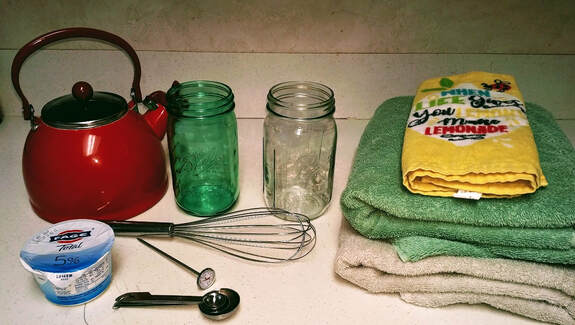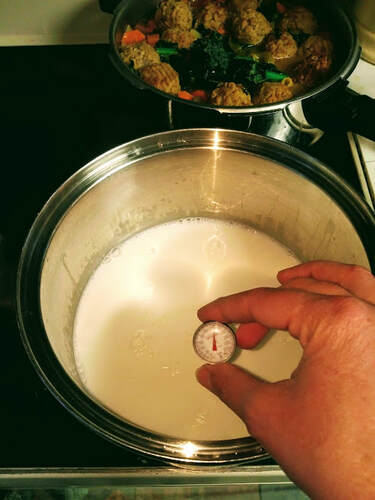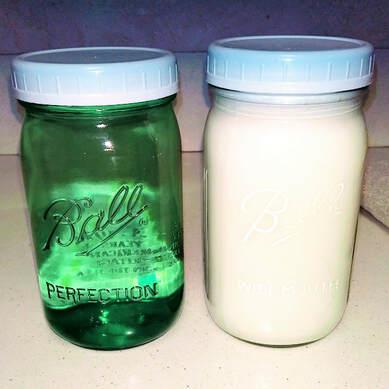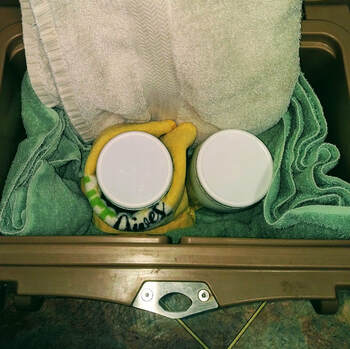Once again, it is spring and we are being blessed with an overabundance of milk. Never one to scoff at abundance, I am busily making things!!!!
I have to start out by saying, THIS WAS NOT MY IDEA!! But I have been making yogurt this way for so many years I have no idea who to give credit to, so if you read this and you originated this idea, please shoot me a line as I would love to give credit to the wonderfully smart and handy person you are!!
So with my abundance, here is how I make yogurt:
I have to start out by saying, THIS WAS NOT MY IDEA!! But I have been making yogurt this way for so many years I have no idea who to give credit to, so if you read this and you originated this idea, please shoot me a line as I would love to give credit to the wonderfully smart and handy person you are!!
So with my abundance, here is how I make yogurt:

Supplies needed:
1 quart of milk (you can double, triple or quadruple this recipe. Just make sure all the jars will fit in your cooler)
2 quart jars with lids
1 pot large enough to warm your milk
A tea kettle or pot to warm water
1 wire whisk
1 candy thermometer-I got mine for 3 dollars at the local supermarket
2 tablespoons of plain yogurt or yogurt culture (I always grab Fage yogurt-it works great)
1 smallish cooler
2-4 towels (bath towels are best, and I use one small kitchen towel too to make sure my milk jars aren’t directly touching my hot jar)
As you can see, no special appliances or equipment are needed! At our house, the only cooler reliably free of fish gut smell is my husband’s lunch cooler, and so far even if I write “Melly’s cooler do not take” on the outside of one, ultimately, it still gets used for fishing adventures. So I have given up. It usually has a little drywall dust on the outside, but we use the lunch cooler.
1 quart of milk (you can double, triple or quadruple this recipe. Just make sure all the jars will fit in your cooler)
2 quart jars with lids
1 pot large enough to warm your milk
A tea kettle or pot to warm water
1 wire whisk
1 candy thermometer-I got mine for 3 dollars at the local supermarket
2 tablespoons of plain yogurt or yogurt culture (I always grab Fage yogurt-it works great)
1 smallish cooler
2-4 towels (bath towels are best, and I use one small kitchen towel too to make sure my milk jars aren’t directly touching my hot jar)
As you can see, no special appliances or equipment are needed! At our house, the only cooler reliably free of fish gut smell is my husband’s lunch cooler, and so far even if I write “Melly’s cooler do not take” on the outside of one, ultimately, it still gets used for fishing adventures. So I have given up. It usually has a little drywall dust on the outside, but we use the lunch cooler.

I start by pasteurizing my milk. You do this by heating it to 180 degrees and keeping it there for 3 minutes. If you let it boil, you will not get the results you are wanting as it changes the proteins and makes it come out wonky. Some people use a double boiler to warm milk. I do not have one so I just use a regular pot on low heat and stir frequently. You will find that as you get close to 180 degrees you can start to get a skin on the top of the milk. Stirring frequently and keeping a lid on in between will help minimize this.
You don’t strictly have to pasteurize first. There are plenty of people who don’t and just make it with raw milk, however I felt like the flavor was a bit off when tried making yogurt without pasturizing first, so that is what we do. Also, unless you know for sure the milk is super clean, I prefer to not “oops” and culture bacteria I was not intending to.
Next, you let the milk cool down to 110-115 degrees. Much warmer than that you will kill your culture. Cooler than that, it won’t set properly. I find that making yogurt is easily done while I am making dinner. That way I am already in the kitchen monitoring things and can monitor my temps easily. Also, the yogurt can culture over night and be ready to put in the fridge in the morning.
Once your milk is almost cooled down enough, pad your cooler with a towel or two.

Then heat water to almost boiling in your tea kettle (180-200 degrees, or if you are like me, boil it and then let it cool down a little). Pour this water into one of your jars and put a lid on it. I wrap this jar in a small kitchen towel to make sure it will not come into direct contact with the other jars and place it into the center of the cooler. It is going to act as your heater to keep your culturing jars warm.
After your milk is cooled to 110-115 degrees, add 2 tablespoons of your yogurt starter and whisk it in well.
Pour cultured milk into your other jar(s) and put a lid on it (You could use 4 half pint jars for this and make individual servings too).
Place cultured milk into cooler with your heater jar.
After your milk is cooled to 110-115 degrees, add 2 tablespoons of your yogurt starter and whisk it in well.
Pour cultured milk into your other jar(s) and put a lid on it (You could use 4 half pint jars for this and make individual servings too).
Place cultured milk into cooler with your heater jar.

Finish wrapping everything up in towels, tuck those jars in and make them cozy. Then place the whole cooler somewhere where it won’t be disturbed for 12-16 hours (the longer you leave it, the more sour it gets).
When the time is up, open your cooler, chill your yogurt and ENJOY!!! If your yogurt came out a little too runny for your taste (this can happen sometimes with goat milk yogurt, just strain it in a cheese cloth for a few hours to strain off the extra fluids. I never bother with this as usually the yogurt our mini-nubians produce is thick enough for me, but I know some other types of goat milk make a thinner yogurt.
We love adding a little stevia, vanilla flavor, fresh fruit and nuts or granola to ours for breakfast or as a mid-morning snack, or using it as a replacement for sour cream on taco night!
What awesome recipes for yogurt do you have?
When the time is up, open your cooler, chill your yogurt and ENJOY!!! If your yogurt came out a little too runny for your taste (this can happen sometimes with goat milk yogurt, just strain it in a cheese cloth for a few hours to strain off the extra fluids. I never bother with this as usually the yogurt our mini-nubians produce is thick enough for me, but I know some other types of goat milk make a thinner yogurt.
We love adding a little stevia, vanilla flavor, fresh fruit and nuts or granola to ours for breakfast or as a mid-morning snack, or using it as a replacement for sour cream on taco night!
What awesome recipes for yogurt do you have?